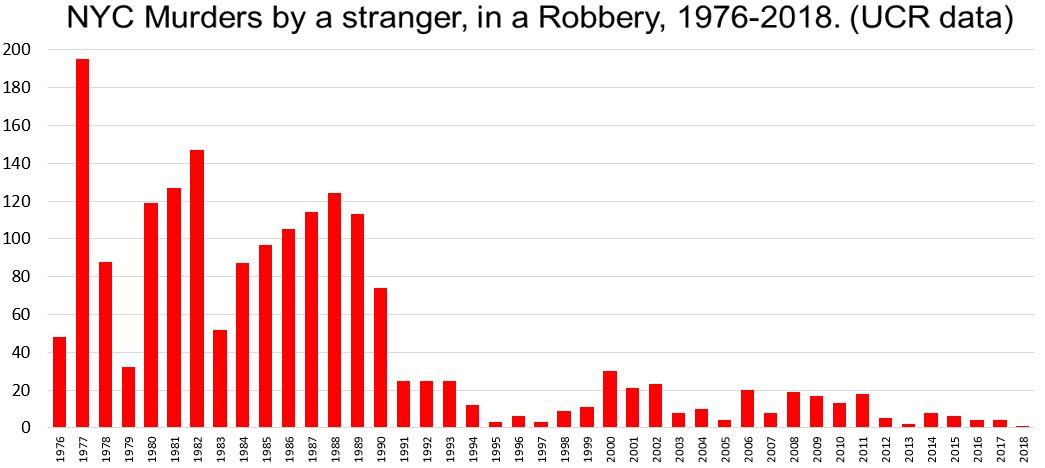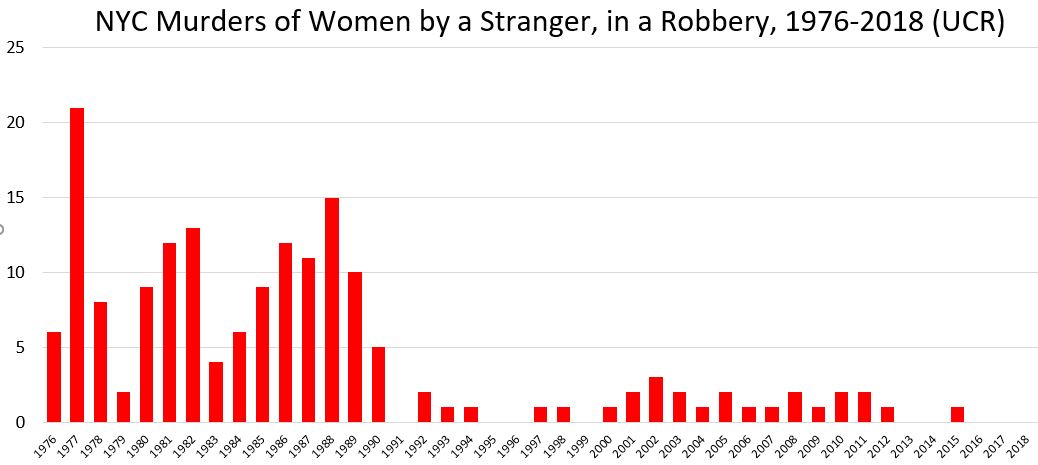Just last month, I swear I told my class, “People won’t talk about crime until a cute white girl gets murdered.” Tessa Majors, unfortunately, is that woman. Would her murder be getting as much press if she had been black? I doubt it. But who knows? Turns out not a lot college students of any race get robbed and killed. But that’s not what I’m going to write about.
Nor am I going to write about that the murder weapon seems to have been a 4-inch folding knife. Why do I point this out? Because this is the exact kind of knife that was made legal just last year, against the advice of law enforcement, and heralded by some as a “heroic” and “a massive victory for justice in New York.” Bravo.
Nor will I go into what Majors might have been doing in the park. Nor the shameful conduct of the SBA (union) President, Ed Mullins, in publicly releasing details of an in-progress investigation to make political hay.
Nor will I touch on the fact that the apparent robbers and murders are but kids, aged 13 and 14. “What can you do?” cops say, “Our hands our tied. They’re kids and weed isn’t enforceable anymore.” That’s bullshit, of course. They seem to have been causing trouble for quite a while. Cops could at least ask, “What are doing and where the hell is your guardian?” and take it from there. That’s where the attention and proactive help needs to be focused. The problem is coming from inside the house. I guarantee it. But if nobody else dares go there, why should I?
Cops, at least in theory, might have prevented this murder with proactive policing. But in doing so they might have become a media sensation. And not in a good way. If you were a police officer and you suspected these kids of previous crimes, would you risk
stopping them on reasonable suspicion? In a park? God forbid the kid is uncooperative and runs. Or puts up a fight. With indignant Columbia students pulling out their phones and calling you racist?
For police, at least in terms of public relations — and this is a current and real problem — it’s probably better to have a poor woman murdered that risk the public indignant public and political pushback from stopping a 13-year-old black kid on suspicion of criminal activity.
I’m not going to talk about any of that. Here’s where I do want to go: the numbers. I like data. And when I looked at them in New York City, I see these kinds of robbery/murders are rare. Really rare. Particularly for women. And then for white women? It basically doesn’t happen. But it did. and I guess that’s the definition of news.
I took the UCR murder numbers [FBI Uniform Crime Reports] for New York City. I excluded “unknowns” for all the variables I’m looking at. That is not a moderate cut, particularly with regards to “offender 1 circumstance” and “victim 1 relation to offender 1.” How much it matters? I don’t know. But it does matter. But perhaps not so much to my main point, which is that this type of crime really is rare.
In the past 20 years — since 2000 — only 2(!) women under 20 have been murdered by strangers in a robbery. It’s the not young who are at risk, but the old. Most women victims are over 50. Five of the 20 women victims were over 80 years old, which seems particularly bad. The last time a white woman of any age was killed by a stranger in robbery was 2015. Before that was 2011 and 2009. All three of the victims were senior citizens. The robber/killers were all in the 30s. One was white, one was black, one was hispanic.
Since 2012, there have been but 30 people murdered by strangers in robberies in New York City. Total. Last year just one person in New York was murdered in a robbery by a stranger. One. A 66-year-old Asian man. In 2017? Four. All men. Same in 2016. There haven’t been more than 10 such murders a year in nearly a decade and not more than 20 such murders in a year since 2002. But in 1988, there there were 124 such victims! It really was a different city.
Since 1992 — arguably when New York City started becoming safe — there have been 28 murders of women (and 287 of men) by strangers in robberies. Yes. Total. Since 1992. In 8 different years since 1990, the number of women killed in robbery has been zero.
As to race, it seems that Asians are disproportionately targeted and victimized. But with that notable exception, victims or robbery/murders seem to reflect the demographics of New York City, at least generally. Offenders are disproportionately (but not exclusively) black men. For the women victims since 1992, 17 were white, 8 black, 2 Asian (1 unknown). Of their robber/killers, 17 were black, 10 white (1 unknown). Two women were murdered by women.


Note the scale of the y-axis is much more magnified on the second picture.
My point is that this type of crime — a woman being killed by stranger in a robbery — is rare in New York City. No, not just for white women. And not just for women. So when something like this does happen, it should be news. No, not cause for alarm and the ever-feared (at least in criminal justice circles) “over reaction.” But no, this shouldn’t be swept under the rug. Because we don’t want to go back to the days when the public lived in fear and people were literally being murdered by strangers in robberies gone wrong on a near daily basis.
Rest in peace, Tessa Majors.

PCM
What is your opinion on urban parks? particularly with regards to crime? How much crime occurs there as opposed other places in the city?
If I recall correctly Jane Jacobs wasn't a fan. Poor use of land, dead spaces. little economic activity, little foot traffic and especially no eyes on the street, which leads to crime.
From Canada
I don't think Jacobs was against parks. She was smart to go after _bad_ parks. Just cause it's a "park" doesn't make it good. An empty green space is bad. But I don't think she had anything against parks that were designed in a way that would attract people to use them, or at least walk through them.
Generally I think parks here are as safe as the rest of the city. This park (Morningside) is a big park. Like Central or Prospect Park. It's also a strange park because it's on a big cliff. It delineates two very different neighborhoods. It was a considered a boundary for Columbia students and has a history and notoriety from the bad old days.
Is any there similar, reliable data available that you could point to – the UCR link requires an affiliation with a member institution (which alas I lack) to gain access? (Please note: this is not a veiled attempt to have you send me the data.)
Otherwise, I really like your post. For what it's worth, I actually happened upon an altercation in the park by the Museum of Science and Industry when I was at UChicago (late 90s). Always the upstanding citizen, I asked the two men if they wanted me to call the police, and they both said "No!" (I think it was a sex purchase gone bad in which neither would have come off very well.) So I didn't.)
I'd be curious (because I was a latecomer to smart phones?) if you want to expound – if not in the comments, then maybe the front page – on the intimidation factor regarding iPhones. It makes me think of Vietnam War protests – "The whole world is watching," etc. Part of me thinks technology changes everything, and how much body cam footage can Internal Affairs or prosecutors review, but part of me also sees the point.
But I digress big time…Back to: data, please?
There are reports of several shootings a week in Cleveland. Not all of them result in death. The news does not focus on them for more than a day or two, because they have to move on to the next shooting. Unless the victim or circumstances really stand out.